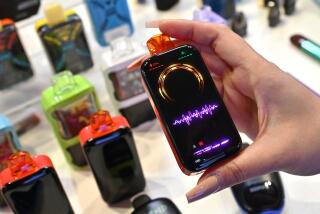Smoking out e-cigarettes
- Share via
Introduced in the United States two years ago, electronic cigarettes are no longer a novelty item but a popular option for many smokers -- especially those who want to quit. Inhaling on the cigarette-shaped device activates a built-in battery, which heats up a mixture of water, nicotine and propylene glycol to give the “smoker” a vapor hit of the addictive substance found in cigarettes -- but without the smoke. It even lights up at the other end, mimicking the tip of a cigarette.
E-cigarettes are the latest of a wave of nicotine-packing products -- including bottled water and lollipops -- to face the wrath of the U.S. Food and Drug Administration. The agency believes it has the authority to regulate them. But marketers of the electronic devices, most of which are made in China, are putting up a big fight. They have sued, arguing that the FDA has no jurisdiction over their merchandise because, unlike nicotine patches or gum, which the agency does regulate, it is not a smoking-cessation product. They also deny the FDA’s contention that e-cigarettes are a drug-delivery device, which the agency also regulates.
In their zeal to avoid regulation, though, spokesmen for this fast-growing business have been engaging in doublespeak. They argue that e-cigarettes are just a “smoking alternative,” and in the same breath tout their superiority over gum or patches as a way to divert smokers from tobacco products.
A kit costing $70 to $100 will last a pack-a-day smoker perhaps 10 days, according to the Electronic Cigarette Assn., and this year, U.S. sales are expected to reach $100 million. Is that a good thing or not? No one knows, which is why the FDA should have regulatory jurisdiction over the devices.
E-cigarettes might help smokers quit by providing the long inhale -- and nicotine fix -- of smoking. Because the devices are smokeless, people could potentially light up at a restaurant or on an airplane without breaking any laws. But with their candy flavors and their image as relatively harmless, e-cigarettes provide a new way to hook customers -- including teenagers -- on nicotine. That could conversely lead to more smoking. Meanwhile, the long-term effects of breathing nicotine and propylene glycol haven’t been determined -- not to mention diethylene glycol, an ingredient in antifreeze that the FDA has found in many e-cigarettes.
The agency wants sales of the devices halted until, as with other drug products, animal studies and clinical trials determine whether they are indeed safe. We agree. A check of Internet chat sites shows that the devices are regularly used by smokers trying to quit tobacco. Should the courts rule against the FDA, Congress will have to step in. With the ever-expanding peddling of nicotine in the United States, the public needs federal oversight of attempts to advance an addictive drug.






